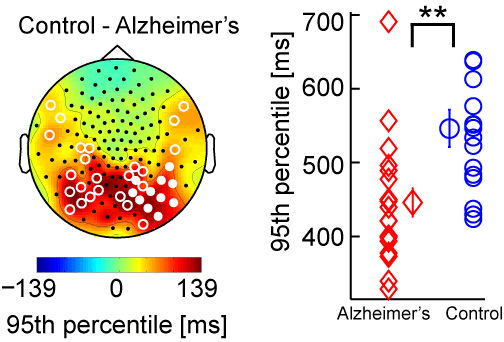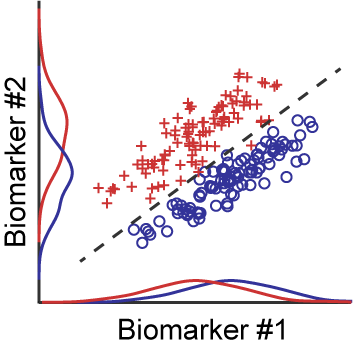

NBT Analytics uses machine learning techniques to combine information from multiple biomarkers.
Unlike traditional analyses that only focus on one or two spectral biomarkers, NBT Analytics investigates biomarkers from temporal and spatial domains allowing for more comprehensive insights into the effect of an intervention on the brain.

NBT combines relevant biomarkers into one integrative index improving statistical power and simplifying the assessment of activity.
The integrated index can be used for prediction, stratification, or quantification of effects.
NBT Analytics' method allows EEG biomarkers to be used as a robust secondary endpoint.
“NBT Analytics provides
a state-of-the-art statistical analysis
of which their cholinergic index can
add considerable value to a
variety of clinical trials.
We will continue to collaborate
with NBT Analytics to provide
the best analyses to our sponsors.”
Geert-Jan Groeneveld MD PHD
Research Director.
Center for Human Drug Research
The Netherlands.




Electroencephalography (EEG) is a non-invasive, inexpensive, and broadly available neuroimaging method to measure neurophysiological activity. EEG is information rich and may give valuable insights on how a drug affects the brain. Quantitative EEG biomarkers, therefore, have great potential as secondary endpoints in clinical trials.
We provide analyses based on a comprehensive selection of EEG biomarkers in the temporal, spatial, and spectral domains. By mapping multiple EEG biomarkers, we obtain a detailed overview of drug-induced changes in brain activity that further can be integrated into sensitive indices (see below).
EEG is particularly sensitive to alterations in the excitatory/inhibitory balance, which is compromised in several brain disorders1. We have developed novel biomarkers that are sensitive to modulations of the excitatory/inhibitory balance and predict an important role of these biomarkers for understanding drug effects in humans2,3,4. One of these biomarkers is the oscillation burst duration, which is strongly affected in early-stage Alzheimer's disease2 (see Figure 1 left)
EEG can be parameterized in multiple biomarkers that often carry complementary sensitivity to drug- or disease-induced changes in brain activity. By combining multiple biomarkers into a single index, we achieve a greater accuracy of classifying the presence of such effects compared to a single-biomarker based analysis (see Figure 2, simulated data).
NBT Analytics has developed an EEG analysis pipeline that identifies the right combination of multiple biomarkers and integrates these biomarkers into an index highly sensitive to a specific intervention or patient group5. The integrated index can for example be used for prognostic purposes or provide a single-value quantification of drug effects for dosage studies.
Recently we have developed a cholinergic index sensitive to effects of drugs on the muscarinic acetylcholine receptors6. The cholinergic system has been implicated in several disorders, such as, dementia, Parkinson's disease, and autism spectrum disorders.


NBT Analytics has strong academic roots, and is committed to the advancement of EEG signal processing to better understand brain states. We believe commercialization is an important step to translate high-quality academic research into applications of value to society. For example, in order to develop better diagnosis or prognosis for patients with a brain disorder or, to map effects of therapeutic interventions whether pharmacological, cognitive-behavioral, or non-invasive neuromodulation.
We welcome requests for collaborations. This can be in the form of joint grant applications where you as an academic researcher will need an SME partner. Or, if you have a medical research question and would like to outsource the complex task of making the best of your EEG data.
Currently, we are a partner of the CognitionNet project funded by the EC under FP7-PEOPLE-2013 (607508).
For questions, please contact Dr Klaus Linkenkaer-Hansen.
We also have a research version of the NBT toolbox available, click here for more information
We have published an article describing our cholinergic and Alzheimer's diesease indices. Simpraga et al, Scientific Reports 7, Article number: 5775 (2017). Read the article here.
NBT Analytics is looking to upgrade the technology, this will include testing and upgrading existing features, developing new functions for data characterization, statistical tests and visualization, and more. In this project there is room to have your own input. There is the strong possibility that upon completion of the project, you will be offered a fulltime job at the company.
Do you match the description and are interested in what we do?
Please send us a motivated email to [email protected] including the following attachments:
This position in based in Amsterdam at the Vrije Universiteit and candidates must therefore live in suitable proximity, the internship is based on 36-40 hours a week for 4-6 months.
Skills and Competences:
We offer:
NBT Analytics BV is a spin-off company from the VU Amsterdam. The company was founded in August 2015 by Dr. Klaus Linkenkaer-Hansen and Dr. Simon-Shlomo Poil.






